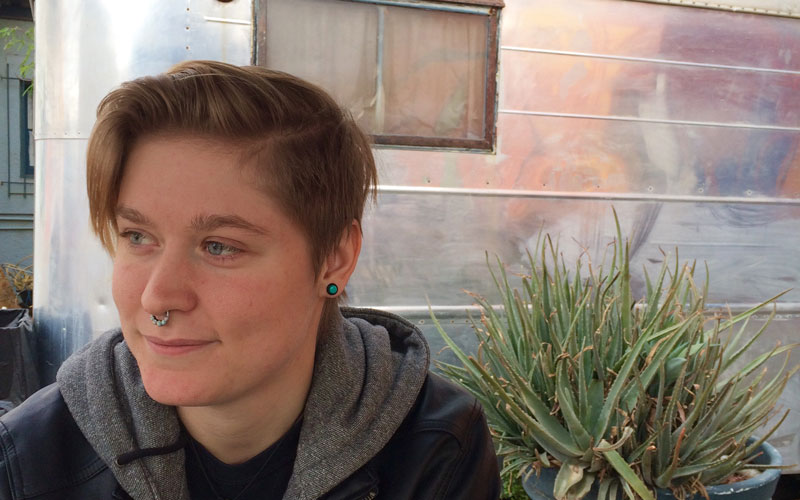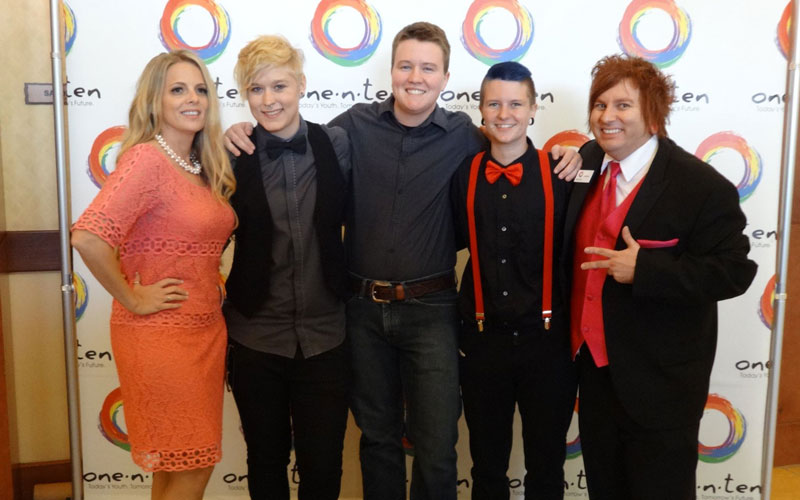
Aiden Grae played the ukulele for money near Fifth and Roosevelt Streets in downtown Phoenix when was homeless. (Courtesy photo)

Aiden Grae (second from left) and other One n Ten members at a gala celebrating 22 years serving the Valley’s LGBTQ youth. (Courtesy photo)
For a while, Aiden Grae lived in park next to Washington High School, his homelessness prompted by an argument with his grandmother over his sexual orientation and gender identity.
The dispute started when Grae lied about going to the Phoenix Pride Festival at Steele Indian School Park.
“I’m a terrible liar,” Grae, now 22, explained. “My grandma replied, ‘You were at Indian School Park weren’t you?'”
“And then she told me I had 30 minutes to pack my things and leave, this was just for supporting the cause, without me ever actually saying I was gay. Walking out the door … I said, ‘Hey, by the way, I’m gay too.'”
Now six years later, Grae laughs at what he calls “an angsty teen” retort, though the reality of his situation proved harsh. Grae was born female, but understood by high school that he was interested in girls and did not feel comfortable identifying strictly as a female or male.
According to a study conducted by the Williams Institute, a think tank at the University of California, Los Angeles School of Law, youth who identify as LGBTQ (Lesbian, Gay, Bisexual, Transgender, Queer) account for no more than 10 percent of the U.S. population.
But they account for 40 percent of homeless youth, and cite difficulties with acceptance from family as one of the most prominent factors in their homelessness.
Grae’s grandparents offered him an opportunity to return home — but only if he attended “conversion” therapy to address his sexuality.
“I just wanted a roof over my head so I agreed,” he said. “I went through a very dark time and it was emotionally and physically tolling. It was a constant battle between how I felt and me wanting to be accepted and have a home and a family.”
After graduating from high school and turning 18, Grae permanently left home and headed to Steele Indian School Park, the very place where he attended the pride festival — this time with a sleeping bag, pillow and duffel full of clothes.
“LGBTQ youth are 40 percent more likely to become homeless and sex trafficked than their heterosexual peers,” said Stacey Jay Cavaliere, director of programs at One n Ten, a local, nonprofit serving Arizona’s homeless youth population.
A survey of more than 10,000 youth ages 13-17 by the national Human Rights Campaign reported that nearly 45 percent of LGBTQ youth say they believed the community where they live is not accepting of them. Among those surveyed, one-third said they felt they did not have an adult they could talk to about their personal problems.
“Four years ago, we did a very extensive annual survey of our youth and their experiences,” said Cavaliere. “That survey told us almost half of those who took the survey had an unsafe living environment, or some sort of instability so we wanted to address it immediately.”
With the last of his money, Grae bought a ukulele and lived on the streets for three months.
“I didn’t want to beg so I learned to play and that’s kind of how I learned to survive,” he said.
“With some other people on the streets you do connect and you do learn to help one another and get along with one another in a way, but you never trust anyone else,” Grae said.
One n Ten has an LGBTQ focus with varying programs for Valley youth. Since its inception in 1993, it has created housing and employment opportunities, mental and behavioral health services, an online public school facility, youth center and annual outdoors camp.
Cavaliere says creating a safe space for homeless LGBTQ is vital, given the dangers they face on the street.
Promise of a New Day, One n Ten’s housing program located in a downtown Phoenix apartment complex, serves 30 youth experiencing homelessness. The number is expected to jump to 40 in the next few months because of a grant the organization recently received, said David Garrett, a solutions advocate at One n Ten.
“The biggest thing, with creating housing in mind, is providing safety for the LGBTQ population,” Garrett said. “Being with the adult population on the streets, they may be engaging in survival sex, receiving housing, clothes or food with a price attached. A lot of those who have come in have had these challenges.”
Grae reconnected with old friends and One n Ten volunteers while playing his ukulele on the streets and applied to be a part of its Promise of a New Day housing program. It turned out he didn’t need it after finding a job at a local restaurant and an apartment.
“I told them ‘I’d rather you give this slot to someone who needs it more than I do,’ ” he said. “I ran into a diversity of kids, especially down 5th Street downtown that needed the opportunity more than I did at the time,” he said.
“Having a sense of community like One n Ten is super important for anyone in a hostile environment because a safe space for anyone in the spectrum is not as readily available as it should be,” Grae added.
Cavaliere said the program is crucial to youth that have been ostracized by family and friends.
“We wish we didn’t have to have a program, but the reality is much different than that. We want to support these young people who are not being embraced by their family or extended family. The want for a family is often the number one reason people come to us,” he said.
Tumbleweed Tempe Youth Resource Center, another local, nonprofit organization founded in 1975, serves 2,000 homeless youths each year offering food, shelter, education and counseling services to those ages 12 to 25. The organization opened its Tempe location 13 years ago, and has faced a backlash from surrounding businesses.
“In terms of creating a safe space in the community that’s hard. In my experience Phoenix is more urban, the attitude is ‘There are homeless people everywhere, that’s life in the big city just deal with it,’ ” said Adi Shakta Khalsa, a solutions advocate at the center. “Here our clients get harassed a lot, but if you’re homeless, where are you going to be?”
The number of youth experiencing homelessness across the country has increased in recent decades, with the Department of Housing and Urban Development estimating that 194,302 children and youth are homeless on any single night, according to a 2014 study.
The National Alliance to End Homelessness estimates that each year approximately 550,000 unaccompanied young adults up to age 24 experience a homelessness episode of longer than one week.
Many of Tumbleweed’s clients are fleeing abusive home situations, abandonment by their parents, or poverty.
“It’s great to meet basic needs at first — sort of like ER triage-ing — but we are a huge organization with tons of resources for these kids, so it’s up to us to go deeper to get them safe and stable,” Khalsa said. “If you’re a client here for four years and you’re still on the street, then we didn’t do our job.”
Tumbleweed, in addition to its Tempe Youth Resource Center, offers programs for emergency and transitional housing, education and career counseling, as well as a mobile street outreach team to pass out water or supplies.
Tumbleweed Program Manager Victor Rojas said about 35 percent of those who come to the Tempe Youth Resource Center also have mental health issues.
“We do our best to help them first acknowledge that there are some challenges for them,” he said. “A lot of people first refuse to acknowledge this, though later if they request some services we refer them to behavioral health organizations that offer free counseling.”
“They age out, they haven’t been given any skills, they’ve been through trauma so yeah, it’s mental health, it’s substance abuse, it’s all of that. But if someone could work with kids before we get them, it would be much less of a problem,” Khalsa said.